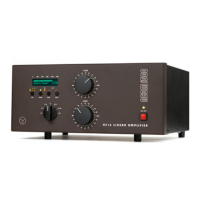
Do you have a question about the Acom 1500 and is the answer not in the manual?
| Power Output | 1500W PEP or continuous carrier |
|---|---|
| Tuning Method | Automatic |
| Cooling | Forced air |
| Impedance | 50 Ohms |
| Input Impedance | 50 Ohms |
| Output Impedance | 50 Ohms |
| Power Supply | 220V AC, 50/60 Hz |
This manual explains the installation, operation, and maintenance of the ACOM 1500 HF + 6 meter linear amplifier.
Contact local dealers or ACOM specialists for assistance, support, and guidance.
Details the items included with the ACOM 1500 amplifier, shipped in a cardboard carton.
Highlights key operational features: TRI, no antenna tuner needed, user-friendly design, OLED display.
Defines safety signal words (Danger, Warning, Caution, Notice) and general safety precautions for safe operation.
Instructions for unpacking the amplifier, inspecting for physical damage, and retaining packing materials.
Guidance on selecting the correct mains voltage for the amplifier to prevent damage.
Recommendations for amplifier placement considering weight, ventilation, magnetic fields, and environment.
Details for connecting grounding, RF input, antennas, KEY-IN/OUT, fuses, power cord, and wall outlet.
Guidance on installing an optional external fan for higher duty cycles or increased ambient temperatures.
Overview of the front panel layout, including the OLED display and essential controls.
Steps to power on the amplifier, including main switch, power button, and warm-up sequence.
Diagram showing navigation of information screens and control functions in OFF LINE and ON LINE states.
Detailed steps for powering the amplifier ON and OFF, including the warm-up sequence and standby mode.
How to switch between OPERATE and STANDBY modes, and the role of AUTO-OPERATE.
Covers selecting antennas, operating in continuous carrier modes, and managing OPERATE/STANDBY.
Covers tuning procedure, TRI aid, presets, and hints for impedance matching.
Accessing and using 12 ON LINE information screens for monitoring parameters.
Explains the amplifier's protection system, including three degrees of protection and fault messages.
Adjusts display brightness; applicable only to VFD displays, not OLED units.
Enables or disables the AUTO-OPERATE feature for automatic mode management.
Allows enabling or disabling specific antenna outputs to prevent no-load transmissions.
How to read and decode auto-protection trip signatures for diagnostics and troubleshooting.
Covers periodic checks of connections, cables, and antenna SWR for upkeep.
Instructions for cleaning the amplifier's outer surface and ventilation apertures safely.
Procedure for replacing primary mains fuses, specifying voltage ratings and suitable fuse types.
Procedure for replacing the amplifier's tube, emphasizing danger and the need for trained technicians.
Presents a simplified block diagram of the amplifier's internal circuitry and signal flow.
Guides on reading, decoding, and interpreting auto-protection signatures for diagnosing issues.
Details operational parameters like frequency range, power output, impedances, and voltage settings.
Lists core functions: impedance matching, antenna outputs, T/R system, and protection features.
Provides guidelines for storage environment, shipping dimensions, weight, and transportation.
Guidance on proper disposal and recycling of the product according to environmental regulations.